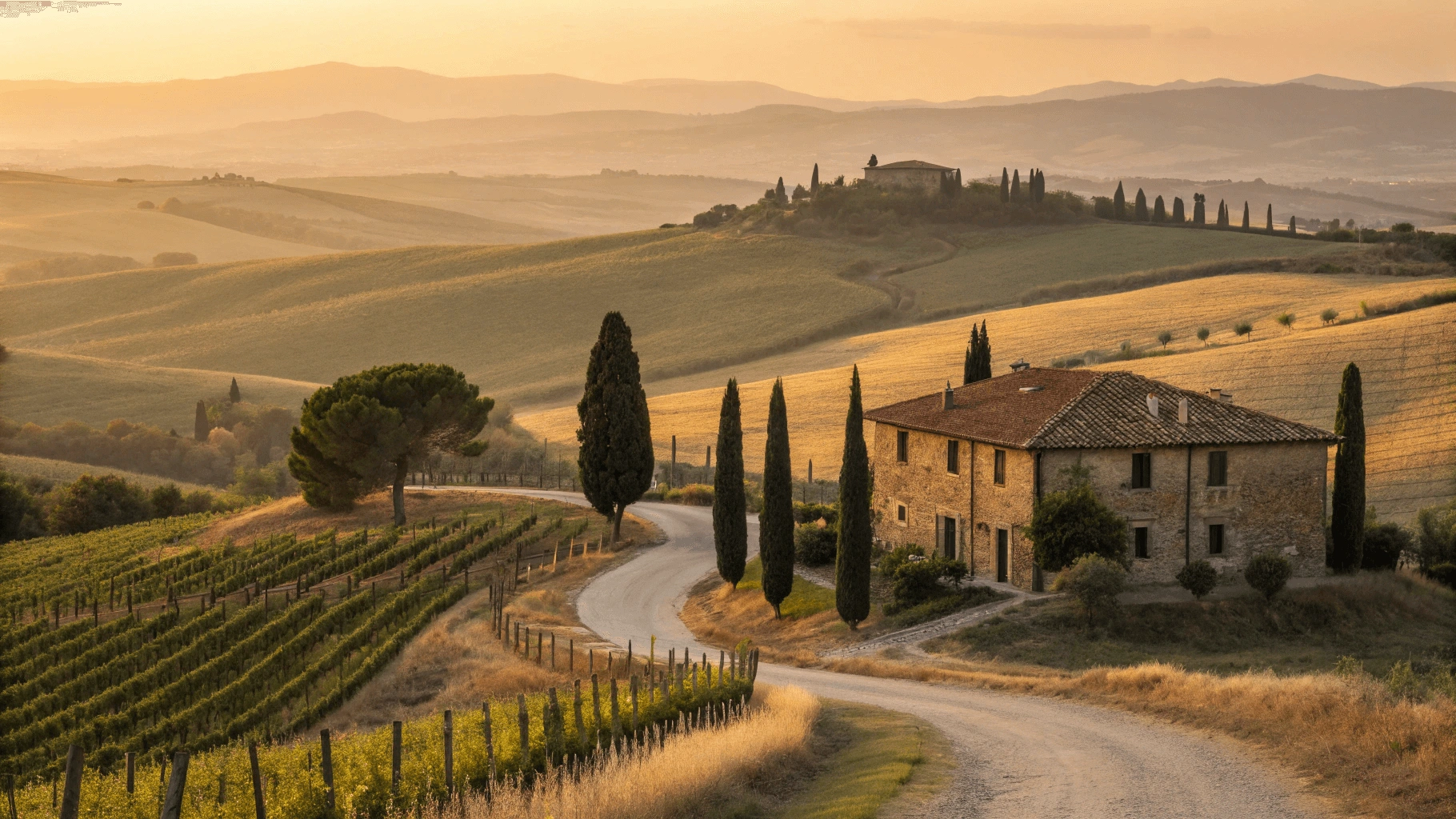Introduction: Tuscany’s Timeless Appeal
Beyond the picture-perfect postcard images of rolling cypress-lined hills and Renaissance masterpieces lies a Tuscany that continues to captivate travelers century after century. This iconic Italian region offers an exceptional blend of artistic genius, culinary excellence, historical richness, and natural beauty that few destinations can match.
Whether you’re dreaming of standing before Michelangelo’s David in Florence, savoring a glass of Chianti Classico in its birthplace, wandering medieval hilltop towns frozen in time, or simply embracing the unhurried pace of rural Italian life, Tuscany rewards visitors with experiences that engage all senses and remain etched in memory long after returning home. Learn more about Tuscany’s historical significance through the UNESCO World Heritage overview highlighting Italy’s cultural contributions.
This comprehensive guide will walk you through everything you need to know to plan an unforgettable Tuscan adventure—from understanding its diverse regions to navigating transportation, selecting accommodations, experiencing its cultural treasures, and indulging in its world-renowned cuisine.
Table of Contents
Why Visit Tuscany?
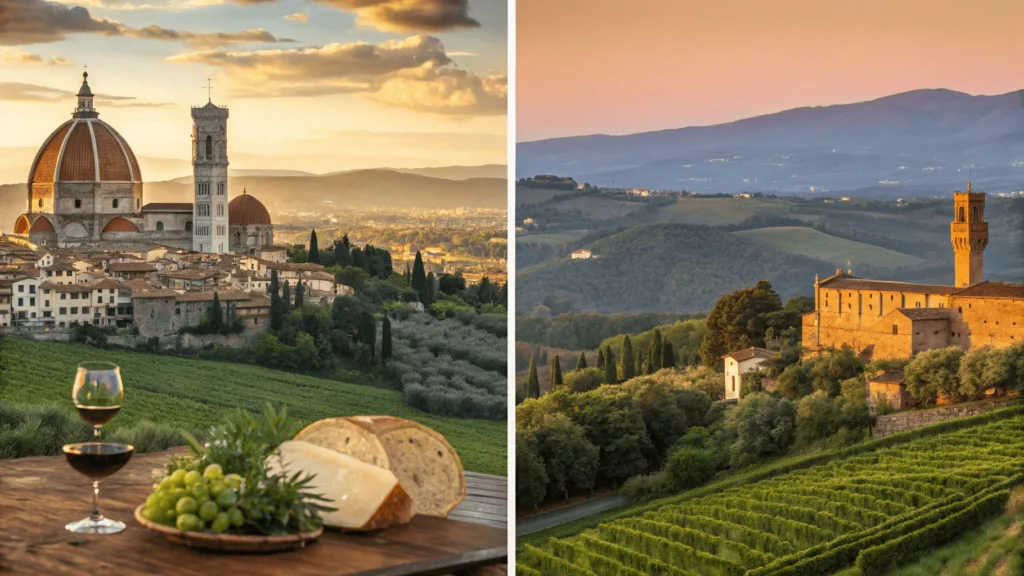
Tuscany’s enduring appeal stems from its remarkable diversity and the quality of experiences it offers:
- Artistic Heritage: Home to an unparalleled concentration of artistic masterpieces, from Florence’s Uffizi Gallery to Siena’s stunning Duomo, The Uffizi Gallery official website offers detailed information about its renowned Renaissance collection.
- Historic Significance: Birthplace of the Renaissance and custodian of Etruscan, Roman, and medieval treasures
- Culinary Excellence: Simple yet sublime cuisine based on high-quality local ingredients and centuries-old traditions
- Picturesque Landscapes: The quintessential Italian countryside with its rolling hills, vineyards, olive groves, and cypress trees
- Architectural Wonders: From Florence’s Duomo to Pisa’s Leaning Tower and countless medieval villages
- Authentic Experiences: Opportunities to connect with locals and experience traditional Italian life beyond the tourist track
What Makes Tuscany Special
“Tuscany offers what I like to call the perfect travel trifecta: spectacular art and architecture, extraordinary food , and stunning landscapes—all within a relatively compact area that rewards slow exploration.”
Tuscany’s magic lies in how these elements intertwine. The region’s landscapes have inspired artists for centuries, its agricultural bounty feeds its remarkable cuisine, and its prosperous history funded the artistic and architectural masterpieces that draw visitors today.
Understanding Tuscany: Geography and History
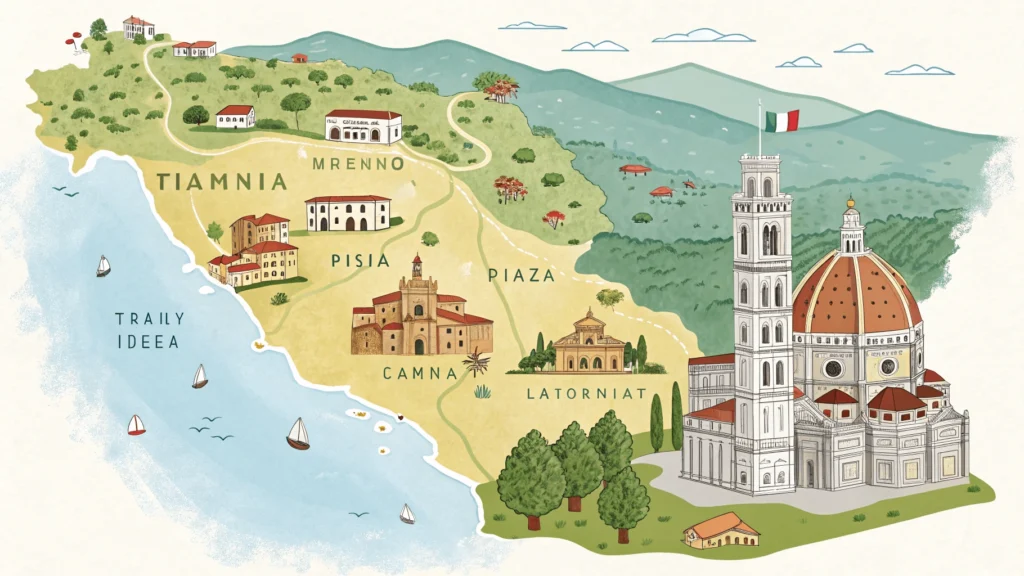
Regional Overview
Tuscany encompasses approximately 8,900 square miles (23,000 sq km) in central Italy, bordered by the Apennine Mountains to the north and east, and the Tyrrhenian Sea to the west. The region is divided into ten provinces, each with its distinct character:
- Florence (Firenze): The regional capital and Renaissance jewel
- Siena: Medieval splendor and home to the famous Palio horse race
- Pisa: Known for its iconic Leaning Tower and historic university
- Lucca: Charming walled city with well-preserved Renaissance walls
- Arezzo: Rich in artistic treasures with fewer tourists
- Grosseto: Gateway to the wilder Maremma region
- Livorno: Major port city with a distinctive character
- Massa-Carrara: Famous for its marble quarries
- Pistoia: Historic center with authentic Tuscan atmosphere
- Prato: Textile center with emerging cultural attractions
Key Sub-Regions for Travelers
| Region | Known For | Don’t Miss |
|---|---|---|
| Chianti | rolling hills | Greve in Chianti, scenic drives |
| Val d’Orcia | UNESCO landscapes, cypress trees | Pienza, Montepulciano, thermal baths |
| Maremma | Rugged coastline, Etruscan sites | Saturnia hot springs, Pitigliano |
| Garfagnana | Mountain landscapes, outdoor activities | Medieval villages, hiking trails |
| Versilia | Beautiful beaches, nightlife | Forte dei Marmi, Viareggio Carnival |
Historical Context for Travelers
Understanding Tuscany’s rich history enhances your travel experience:
- Etruscan Civilization (800-100 BCE): Pre-Roman civilization that left a significant mark on Tuscan culture, visible in museums and archaeological sites throughout the region
- Roman Period (1st century BCE-5th century CE): Roman influence evident in city layouts, ruins, and infrastructure like the Via Francigena pilgrimage route, For historical maps and modern travel guides to the ancient Via Francigena, visit the official Via Francigena website.
- Medieval Era (5th-14th centuries): Saw the rise of powerful city-states and the construction of many of Tuscany’s most iconic buildings and towns
- Renaissance (14th-17th centuries): Florence-centered cultural rebirth that revolutionized art, architecture, literature, and science
- Medici Influence: The powerful banking family shaped much of Tuscany’s cultural landscape through their patronage
- Modern Tuscany: Evolved from Grand Duchy to part of unified Italy while preserving its unique cultural identity
Best Time to Visit Tuscany
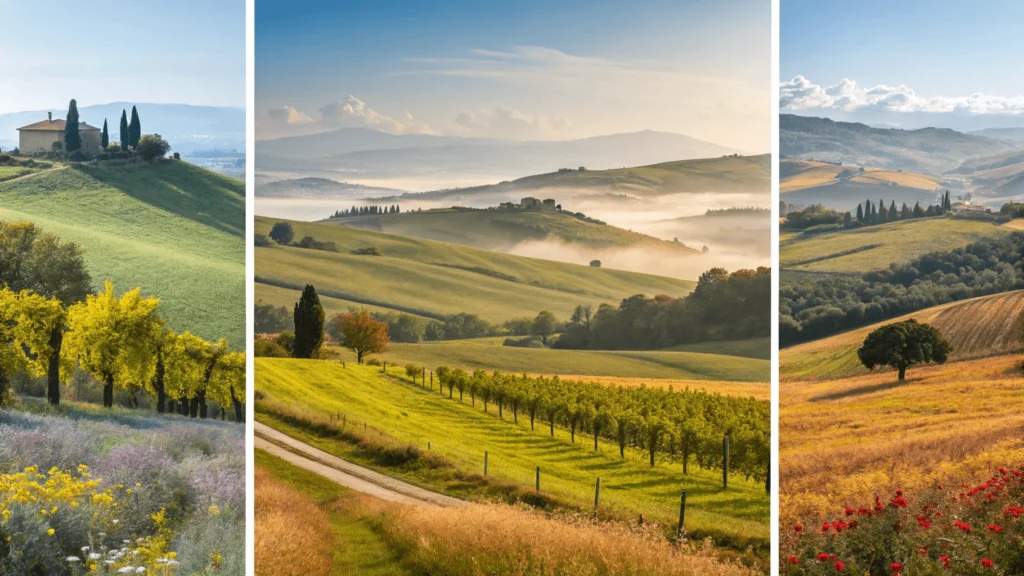
Tuscany’s climate features hot, dry summers and mild, relatively wet winters. Each season offers a different experience:
Seasonal Breakdown
Spring (April-May)
- Weather: Mild temperatures (60-75°F/15-24°C), occasional rain showers
- Crowds: Moderate, building toward summer
- Pricing: Mid-range, increasing in late May
- Pros: Beautiful wildflowers, green landscapes, comfortable temperatures
- Cons: Variable weather, some attractions have limited spring hours
- Special Events: Easter celebrations, flower festivals, Maggio Musicale in Florence
Summer (June-August)
- Weather: Hot (75-90°F/24-32°C), very sunny, minimal rain
- Crowds: Peak tourist season, especially July-August
- Pricing: Highest of the year
- Pros: Long daylight hours, all attractions open, lively atmosphere
- Cons: Heat (especially inland), crowds, higher prices
- Special Events: Palio di Siena (July 2 & August 16), numerous village festivals, outdoor concerts
Fall (September-October)
- Weather: Mild (55-75°F/13-24°C), some rain in October
- Crowds: Moderate, decreasing by late October
- Pricing: Mid-range
- Pros: Harvest season, beautiful colors, comfortable temperatures
- Cons: Increasing chance of rain by mid-October
- Special Events: truffle fairs, olive oil pressing
Winter (November-March)
- Weather: Cool (40-55°F/4-13°C), more rain, occasional snow in higher elevations
- Crowds: Low (except Christmas/New Year)
- Pricing: Lowest (except holidays)
- Pros: Few tourists, authentic local experiences, winter cuisine
- Cons: Shorter days, some rural accommodations closed, rain
- Special Events: Christmas markets, Carnival celebrations, winter truffle season
Shoulder Season Benefits
May and September-October offer the best combination of good weather, fewer crowds, and reasonable prices. These months allow for more authentic experiences as you’ll encounter more locals and fewer tour groups. Fall is particularly magical with harvest activities and beautiful colors across the countryside.
Getting There & Around
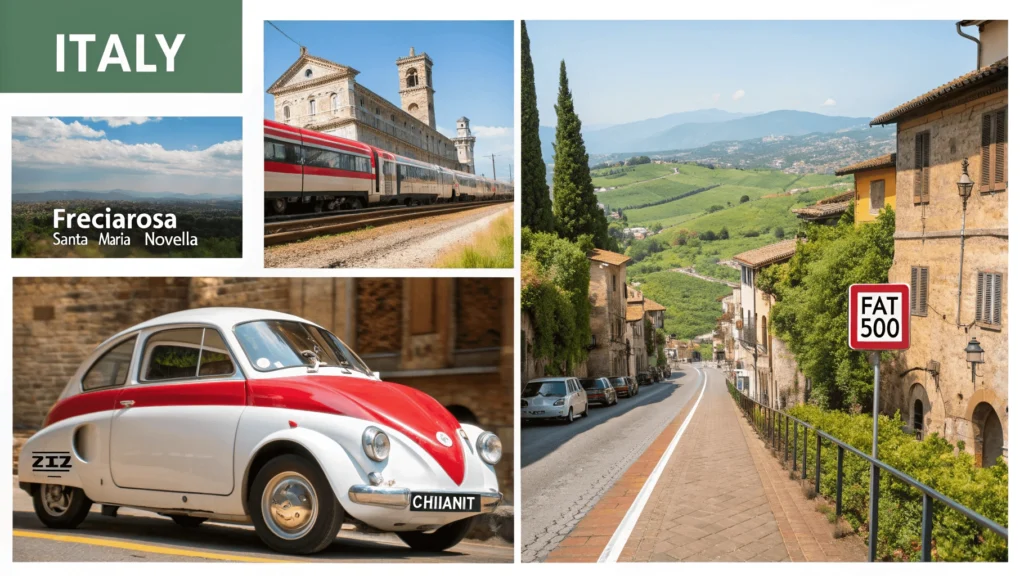
Flying to Tuscany
Tuscany has two main airports:
- Florence Airport (FLR): Smaller but conveniently located just 4km from Florence’s center. Offers connections to major European hubs.
- Pisa International Airport (PSA): Larger facility with more budget airline options, located 80km west of Florence.
Many travelers also fly into:
- Bologna Airport (BLQ): 100km north of Florence with excellent train connections
- Rome Fiumicino (FCO): Larger international airport about 2.5 hours by train from Florence
Train Travel
Italy’s rail network provides excellent connectivity to and within Tuscany:
- High-speed trains (Frecciarossa, Italo) connect Florence to Rome (1.5 hours), Milan (1.75 hours), and Venice (2 hours)
- Regional trains link major Tuscan cities and many smaller towns
- Tips for train travel:
- Book high-speed trains in advance for best prices
- Regional tickets have a 2-month validity but must be validated before boarding
- Download the Trenitalia app for easy booking, Explore train schedules and ticket options directly at Trenitalia’s official website.
- Consider a regional pass if making multiple journeys
Driving in Tuscany
A car offers the greatest flexibility for exploring rural Tuscany but comes with challenges:
- Car Rental: Available at all airports and major cities. International driving permit recommended but not strictly required.
- ZTL Zones: Limited Traffic Zones (Zone a Traffico Limitato) restrict vehicle access in most historic centers. Violations result in significant fines.
- ZTL Tips:
- Study zone maps carefully before driving
- Many hotels can arrange temporary access for check-in/out
- Park outside city walls and walk or use public transportation
- Never enter a ZTL unless specifically authorized
- Parking: Usually available outside historic centers but can be expensive in cities
- Road Types:
- Autostrade (A): Toll highways, fastest routes between major destinations
- Strade Statali (SS): National roads, good condition, no tolls
- Provincial and local roads: Variable quality, often scenic but slower
Public Transportation
- Intercity Buses: Connect towns not served by trains, operated by various companies (SITA, Tiemme, etc.)
- Urban Buses: Available in all major cities
- Bike Sharing: Available in Florence and other larger cities
- Taxis: Available but expensive; must be called by phone or found at designated stands in smaller towns
Top Regions & Cities Overview
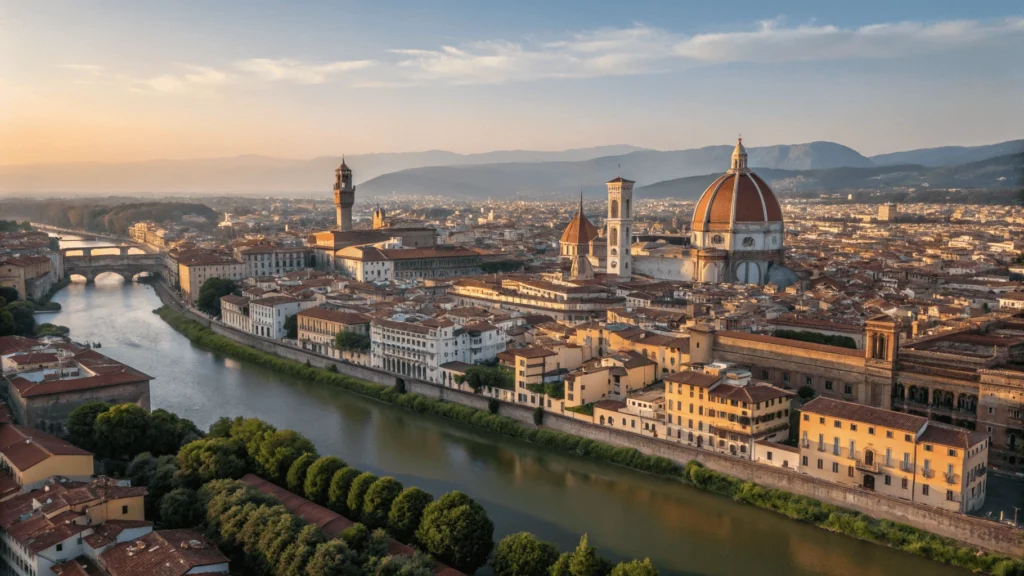
Florence (Firenze)
The cradle of the Renaissance and Tuscany’s capital deserves at least 2-3 full days:
- Don’t Miss: Uffizi Gallery, Accademia (David), Duomo complex, Ponte Vecchio, Pitti Palace
- Character: Urban sophistication, artistic riches, vibrant atmosphere
- Best For: Art lovers, history enthusiasts, urban explorers
Siena
Medieval masterpiece built around the distinctive shell-shaped Piazza del Campo:
- Don’t Miss: Piazza del Campo, stunning Cathedral (Duomo), Civic Museum
- Character: Gothic architecture, strong local traditions, elegant atmosphere
- Best For: Medieval history fans, photographers, those seeking authentic traditions
Pisa
Much more than just the Leaning Tower:
- Don’t Miss: Piazza dei Miracoli complex (Tower, Cathedral, Baptistery), River Arno walks
- Character: University town with youthful energy beyond the tourist center
- Best For: Architecture enthusiasts, day-trippers, science history buffs
Lucca
Charming walled city with intact Renaissance-era fortifications:
- Don’t Miss: Walking/cycling the city walls, Piazza dell’Anfiteatro, San Martino Cathedral
- Character: Relaxed, bicycle-friendly, music-loving (birthplace of composer Puccini)
- Best For: Families, cyclists, those seeking a less touristic experience
San Gimignano
Famous for its medieval towers forming a unique skyline:
- Don’t Miss: Tower-climbing opportunities, Collegiate Church, gelato at award-winning Gelateria Dondoli
- Character: Medieval time capsule, stunning hilltop position
- Best For: Photographers, medieval history enthusiasts, day-trippers
Chianti Region
The heart of Tuscan between Florence and Siena:
- Character: Rolling vineyards, stone farmhouses, cypress-lined roads
- Best For: romantic getaways, photographers
Val d’Orcia
UNESCO-protected landscape of exceptional beauty:
- Don’t Miss: Pienza (ideal Renaissance town), Montepulciano, Bagno Vignoni thermal waters
- Character: Quintessential Tuscan landscapes, agricultural traditions
- Best For: Photographers, food , countryside enthusiasts
Must-Do Experiences
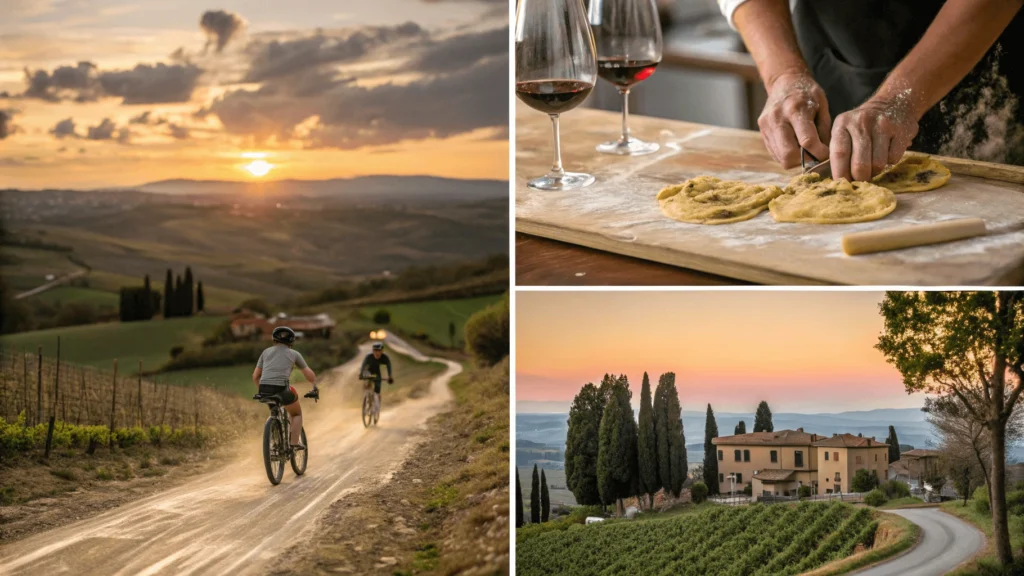
Tuscany offers experiences that engage all senses and create lasting memories:
Art & Culture
- Renaissance Masterpieces: Stand before Botticelli’s “Birth of Venus” at the Uffizi and Michelangelo’s “David” at the Accademia
- Lesser-Known Gems: Explore the frescoes of San Gimignano’s Collegiate Church or Piero della Francesca’s works in Arezzo
- Living Museums: Experience entire cities like Siena that function as open-air museums of medieval and Renaissance life
Food Experiences
- Cooking Classes: Learn to make pasta, traditional sauces, and desserts from local experts
- Market Tours: Explore vibrant markets like Florence’s Mercato Centrale or local farmers’ markets
- Farm Visits: Experience agricultural traditions at working farms producing olive oil, cheese
Countryside Activities
- Scenic Drives: Follow routes like the SR222 “Chiantigiana” or the roads through Val d’Orcia
- Hiking: Walk sections of the Via Francigena pilgrimage route or explore national parks
- Cycling: Pedal through vineyard-covered hills or along ancient Roman roads
Authentic Traditions
- Festival Participation: Experience local traditions like Siena’s Palio or village sagre (food festivals)
- Artisan Workshops: Visit craftspeople continuing traditions in leather, ceramics, or paper-making
- Truffle Hunting: Join hunters and their trained dogs searching for these culinary treasures
Accommodation Guide
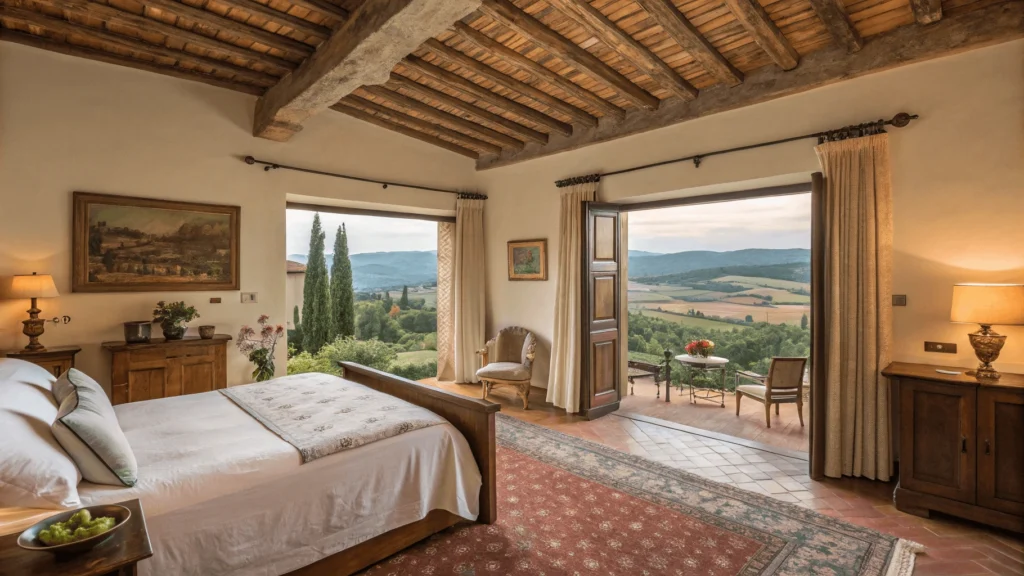
Tuscany offers diverse lodging options to suit different preferences and budgets:
Types of Accommodation
Agriturismos
Working farms offering accommodations, often with home-cooked meals using estate-produced ingredients. Ranges from rustic to luxury.
Best for: Authentic rural experiences, food enthusiasts, tranquility seekers Price range: €80-300 per night Tips: Book well ahead for summer stays; confirm amenities as they vary widely
Historic Hotels
Converted palaces, monasteries, or noble residences offering unique atmosphere and often central locations.
Best for: History lovers, special occasions, those seeking character Price range: €120-500+ per night Tips: Research the specific historic features; older buildings may lack some modern amenities
Villas
Private homes (often historic) available for rent, typically with kitchens and outdoor spaces.
Best for: Families, groups, longer stays, self-catering travelers Price range: €1,000-10,000+ per week Tips: Book through reputable agencies; consider shoulder season for better value
City Hotels
Range from simple 2-star establishments to luxury 5-star properties.
Best for: City explorers, convenience-focused travelers, shorter stays Price range: €70-500+ per night Tips: Consider location relative to attractions and transport; check for parking if driving
B&Bs and Guesthouses
Smaller, often family-run properties offering personalized service.
Best for: Budget-conscious travelers, those seeking local insights Price range: €60-150 per night Tips: Communicate arrival times; take advantage of host recommendations
Where to Stay Based on Interest
| Interest | Recommended Areas | Why |
|---|---|---|
| Art & Architecture | Florence, Siena, Arezzo | Proximity to major museums and historic sites |
| Food | Chianti, Montalcino, San Gimignano | excellent restaurants |
| Rural Tranquility | Val d’Orcia, Maremma, Garfagnana | Beautiful landscapes, fewer tourists |
| Beach Access | Versilia, Maremma coast | Quality beaches, seaside towns |
| Family-Friendly | Lucca, larger agriturismos, coastal areas | Safe, contained environments, activities |
Food & Introduction
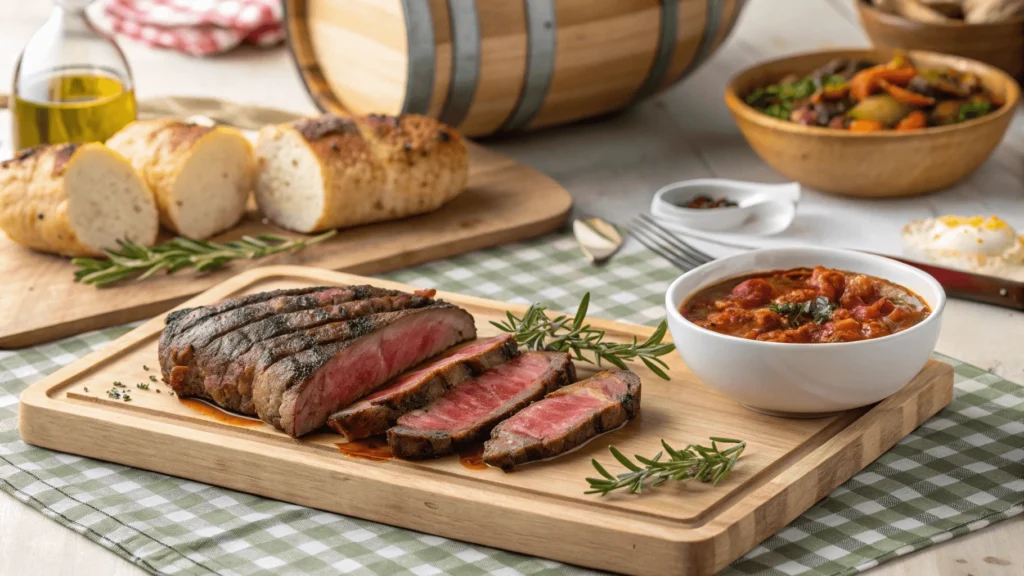
Tuscan cuisine celebrates simplicity and high-quality ingredients, following the Italian principle of “cucina povera” (poor cooking) that transforms humble ingredients into exceptional dishes.
Iconic Tuscan Dishes
- Bistecca alla Fiorentina: Thick-cut T-bone steak, grilled rare over wood fire
- Pappa al Pomodoro: Bread and tomato soup, a tasty way to use stale bread
- Ribollita: Hearty vegetable and bread soup, traditionally reheated (“reboiled”)
- Pici: Hand-rolled thick spaghetti, often served with wild boar sauce
- Pecorino Toscano: Sheep’s milk cheese in various aging stages
- Cinghiale: Wild boar, prepared in stews or as cured meat
- Cantucci: Almond biscotti, traditionally dipped in Vin Santo dessert
Dining Etiquette
- Meal Timing: Lunch typically 1-3pm, dinner 8-10pm
- Courses: Traditional meals include antipasto, primo (pasta/soup), secondo (meat/fish) with contorno (vegetables), dolce
- Ordering: Not necessary to order every course; sharing is becoming more acceptable
- Tipping: Service (coperto) often included; additional tipping appreciated but not expected
- Coffee: Cappuccino mainly consumed at breakfast; espresso after meals
Essential Planning Tips
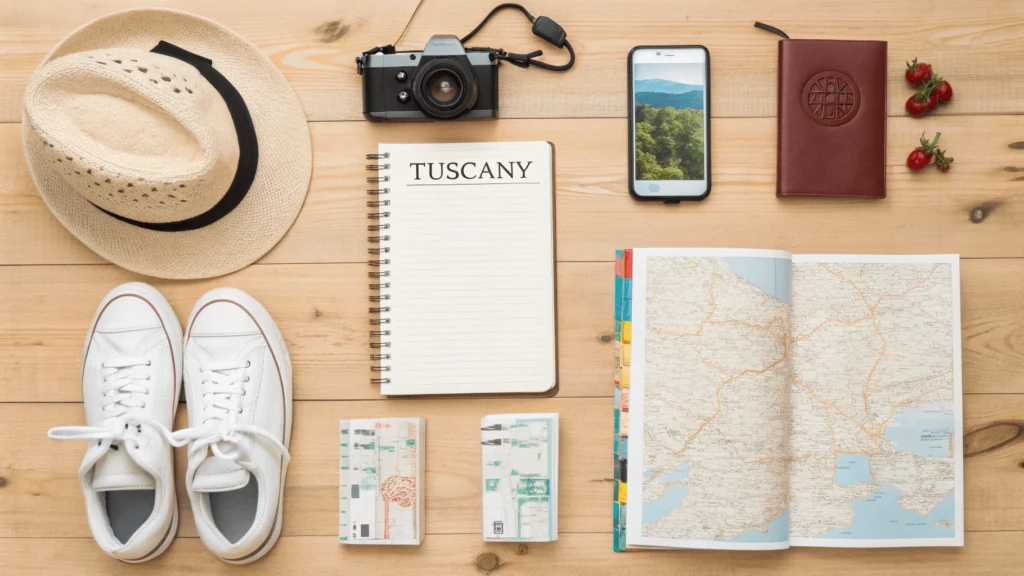
Budgeting for Tuscany
Tuscany can accommodate various budgets with smart planning:
- High Season (June-August): Expect to pay 30-50% more for accommodations
- Daily Budgets:
- Budget: €80-120 per person (hostels/simple B&Bs, picnics, public transport)
- Mid-range: €150-250 per person (3-star hotels/agriturismos, moderate restaurants, car rental)
- Luxury: €300+ per person (luxury hotels, fine dining, private tours)
- Money-Saving Tips:
- Museum passes for Florence or Siena if visiting multiple sites
- Prix-fixe lunch menus at restaurants (often better value than dinner)
- Shopping at local markets for picnic supplies
- Staying in smaller towns with day trips to major cities
Packing Essentials
- Clothing: Layers for variable weather; modest attire for church visits (covered shoulders/knees)
- Footwear: Comfortable walking shoes for uneven streets and countryside paths
- Technology: Camera, phone adapters (Italy uses Type F plugs, 230V)
- Documents: Passport, travel insurance, driving documents if applicable
- Seasonal: Sunscreen and hat (summer); light raincoat (spring/fall); warm layers (winter)
Safety Considerations
Tuscany is generally very safe for travelers, with normal precautions advised:
- Common Issues: Pickpocketing in tourist areas, especially Florence and Pisa
- Road Safety: Familiarize yourself with Italian driving rules; be cautious on narrow rural roads
- Emergency Numbers: 112 (general emergency), 118 (medical)
- Health: Tap water is safe to drink; pharmacies can handle minor medical needs
Language Basics
While English is widely spoken in tourist areas, learning a few Italian phrases is appreciated:
- Buongiorno/Buonasera (Good day/evening)
- Per favore (Please)
- Grazie (Thank you)
- Parla inglese? (Do you speak English?)
- Il conto, per favore (The bill, please)
- Dov’è il bagno? (Where is the bathroom?)
Booking Timeline
For the best experience, follow this recommended timeline:
- 6-12 months ahead: Book flights, reserve popular agriturismos or villas (especially for summer)
- 3-6 months ahead: Arrange car rental, book city hotels, reserve tickets for major museums
- 1-3 months ahead: Book high-demand restaurants, specialized tours
- 2-4 weeks ahead: Plan detailed itinerary, make reservations for local transportation
Sample Itineraries
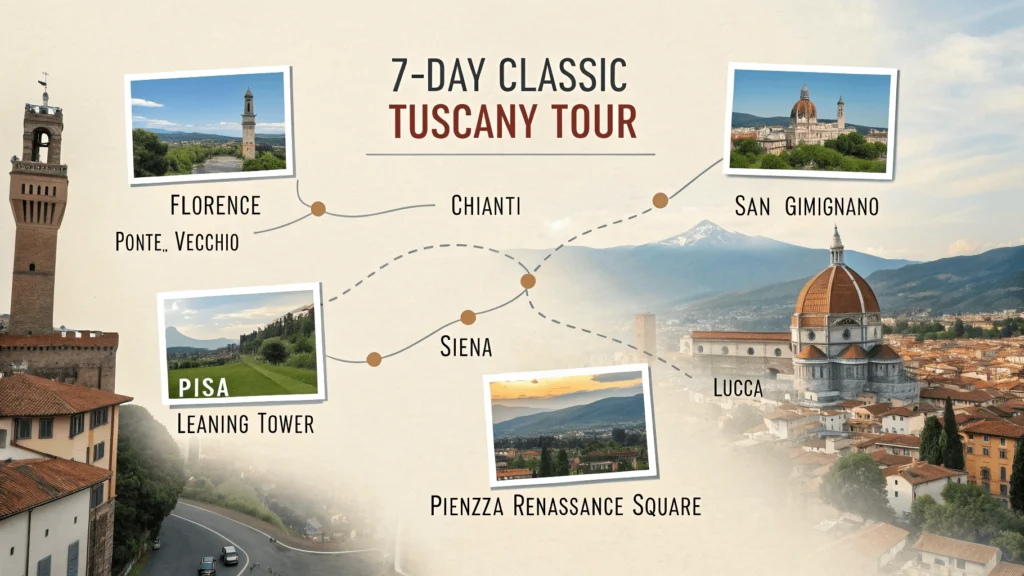
Classic 7-Day Tuscany Tour
Days 1-2: Florence
- Uffizi Gallery, Accademia, Duomo complex
- Oltrarno district exploration
- Evening passeggiate (strolls) along the Arno
Day 3: Chianti Day Trip
- Scenic drive through vineyards
- Medieval village exploration
Days 4-5: Siena & San Gimignano
- Siena Cathedral and Piazza del Campo
- San Gimignano towers and countryside views
- Local food experiences
Day 6: Pisa & Lucca
- Morning in Pisa (Leaning Tower and cathedral)
- Afternoon in Lucca (city walls, historic center)
Day 7: Val d’Orcia
- Pienza’s Renaissance perfection
- Scenic photography stops
Specialized 10-Day Food & Immersion
Days 1-2: Florence Culinary Introduction
- Market tour and cooking class
- Food history walking tour
- Traditional Florentine dinner experiences
Days 3-4: Chianti Deep Dive
- Olive oil producer tour
- Cooking lesson at an agriturismo
Days 5-6: Montalcino & Val d’Orcia
- Brunello producer visits
- Cheese farm experience
- Pienza culinary traditions
Days 7-8: Southern Tuscany & Maremma
- Seafood traditions on the coast
- Wild boar specialties
Days 9-10: Mugello & Northern Tuscany
- Truffle hunting experience
- Chestnut traditions
- Mountain cuisine exploration
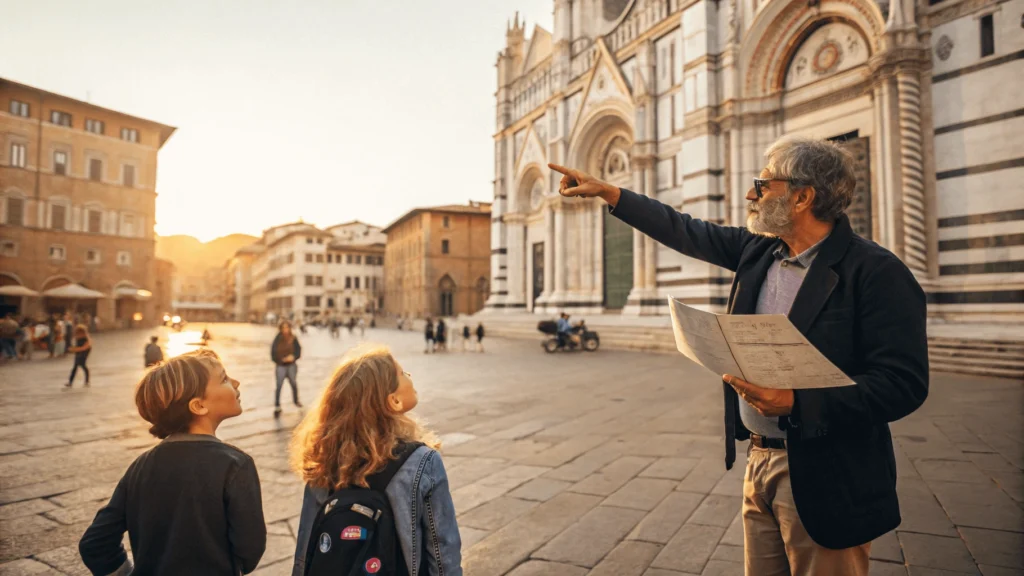
Frequently Asked Questions
Q: How many days do I need in Tuscany?
A: At minimum, 5-7 days allows you to experience Florence plus several other highlights. For a deeper appreciation, 10-14 days is ideal, allowing time to explore multiple regions at a relaxed pace.
Q: Do I need a car in Tuscany?
A: It depends on your itinerary. Florence, Pisa, and Siena are well-connected by train and bus. For exploring smaller towns and countryside areas, a car provides the most flexibility. Consider a mixed approach—city stays without a car, then rent one for rural exploration.
Q: Which is better—staying in cities or in the countryside?
A: Each offers different advantages. City-based stays provide easy access to major sights and dining options without driving. Countryside accommodations offer tranquility, authentic experiences, and often better value. Many travelers enjoy combining both approaches.
Q: Is Tuscany suitable for families with children?
A: Absolutely! Kids enjoy medieval castles, gelato, open spaces, and interactive museums. Agriturismos often have animals, pools, and room to run. Cities like Lucca are particularly family-friendly with traffic-free centers and approachable attractions.
Q: When is the best time to see Tuscany’s famous landscapes?
A: Late April through June offers green rolling hills with wildflowers, while September through mid-October features harvest colors and excellent light for photography. Summer (July-August) brings golden wheat fields but also heat and crowds.
Q: Can I visit Tuscany on a budget?
A: Yes, with planning. Consider traveling in shoulder season, staying in smaller towns, using public transportation, enjoying picnic lunches, and focusing on free experiences like town walks and church visits. Many of Tuscany’s best experiences—like soaking in the atmosphere of historic towns—cost nothing.
Q: How much Italian do I need to know?
A: In tourist areas, English is widely spoken. However, learning basic phrases improves your experience and is appreciated by locals. Even simple greetings and thank-yous go a long way in creating positive interactions.
Q: What’s the best way to experience authentic Tuscan culture?
A: Venture beyond the major tourist sites, visit small towns on market day, attend local festivals (sagre), eat where the locals eat (follow workers at lunchtime), and stay in family-run accommodations where hosts often share insights and recommendations.
Tuscany rewards those who approach it with curiosity, openness, and a willingness to step off the well-trodden path. Whether you’re drawn by its artistic masterpieces, culinary traditions, historic cities, or idyllic landscapes, this remarkable region offers experiences that will linger in memory long after your return home.
The true beauty of Tuscany lies not just in its picture-perfect scenes, but in the way it invites visitors to slow down, savor the moment, and connect with a way of life that values quality, tradition, and the simple pleasures that make life worth living.
Plan your Tuscan journey with care, allow room for spontaneous discoveries, and prepare to fall under the spell of this extraordinary corner of Italy that continues to capture the imagination of travelers from around the world.

